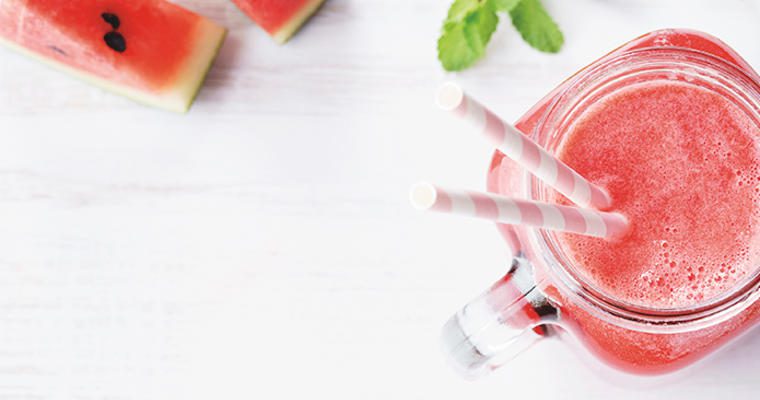The foodservice industry looks to beverages as a way to build better margins. With sales of traditional carbonated sodas in rapid decline, and on-premises alcohol sales showing only modest growth potential, craft sodas and creative blended beverages stand out as ways to enhance the guest experience while creating menu differentiation.
According to a June 2015 Mintel research report, the natural/craft beverage segment—defined as featuring real sugar, containing 100 percent natural ingredients, and manufactured in small batches and/or labeled as “handcrafted”—is growing in popularity. Restaurants are perfectly positioned to take the lead in this consumer-driven trend.
Pop go the craft sodas
Housemade soft drinks are simple and relatively inexpensive. Use a concentrate of flavored syrup as the base and blend with carbonated water or seltzer, pre-mixed in a tap dispenser or carbonated with a CO2 canister.
In Chicago, the Dawson takes a nod from traditional soda fountains and makes liberal use of aromatics and phosphates, blending artisan craftsmanship with retro flavor combinations. Its cherry phosphate features tart cherry syrup and phosphoric acid powder, while its hauntingly complex take on a Greyhound combines grapefruit, pineapple gomme[cq] syrup, juniper and bergamot. The gomme syrup serves as an emulsifier to produce a silky mouthfeel that adds depth to the finished beverage.
Dusek’s, also in Chicago, purées—but doesn’t strain—its syrup bases in order to concentrate the flavor and provide a finished beverage that’s opaque rather than clear. “The presentation is striking,” says Gordon Food Service Corporate Consulting Chef Gerry Ludwig, CEC, “and the color and flavor are quite intense.” A good example is Dusek’s blackberry-tarragon pop, a jewel-colored flavor bomb with a thick layer of creamy foam and a garnish of fresh tarragon.
While fruit-based sodas are arguably the most popular, herbs and vegetables make a strong showing. In New York, Jeffrey’s Grocery features a lemon verbena-maple soda. The cucumber-celery soda at The Breslin Bar & Dining Room, also in New York, is a refreshing blend of fresh cucumber, celery juice, lime and celery bitters.
“Bitters and tinctures,” Ludwig notes, “are a great way to create different layers of flavor.” The Dawson creates its own blends by steeping herbs, spices or fruits in grain alcohol for one month. The resulting infusion is strained and placed in an atomizer. Such proprietary formulations are easy to make, completely stable and add an attractive aromatic quality to the finished beverage.
Opportuni-tea
Matcha, the powdered hand-picked first growth of green tea leaves, is a premium product with explosive growth in the beverage trend segment.
Ludwig says, “the primary attraction, for many, is the significant amount of antioxidants, caffeine and L-theanine, a naturally occurring amino acid.” Ludwig noted the growth of the matcha trend during Gordon Food Service-led cross-country tasting tours. “This combination supposedly provides a slow release of caffeine for sustained energy and mental clarity.”
While traditionally served as a ceremonial cup of tea whisked vigorously with hot water, most matcha in the U.S. is prepared for barista-style beverages like lattes, cortados and hot chocolate. While the extremely fine powder can be challenging to blend using a traditional milk steamer, there are workarounds. In New York, Matcha Café Wabi streamlines the process by making a pre-prepared paste that can be quickly steamed with milk (regular, almond or soy) and sweetener for efficient service.
In addition to hot beverages, matcha lemonades, juices and iced teas are gaining popularity. MatchaBar, also in New York, blends fresh-squeezed juices and matcha iced tea in combinations such as watermelon, cucumber and fuji-apple-ginger. These light and refreshing sippers show the full range of matcha possibilities.
Smoothie moves
Smoothies have been around forever, but on-trend versions are taking this popular beverage to the next level with unique flavor combinations, creative garnishes and a focus on health.
As consumers have become more concerned about sugar intake, smoothies incorporating vegetables such as kale, spinach, avocado and celery have become more popular. In Chicago, Left Coast boasts a creative lineup of signature smoothies such as the “Kale Mary’” with blueberry, kale, avocado, orange juice and maca[cq] powder, along with customization options that allow customers to create their own blend. Thrive 360, also in Chicago, blends açai with Greek yogurt, banana, vanilla protein and almond milk—a straightforward combination with broad appeal. Açai berries, touted as a superfood rich in antioxidants, have a tremendously high pectin content and make an especially thick, creamy smoothie without the need to add dairy products. Açai is available in powdered form or as a frozen purée, though Ludwig recommends the latter as it offers superior texture and flavor.
The bottom line? Freshly prepared and distinctive beverages offer solid opportunities to add flavor to the menu, bolster sales and increase margins while creating menu differentiation. This means revamping your beverage program has never looked sweeter.




























